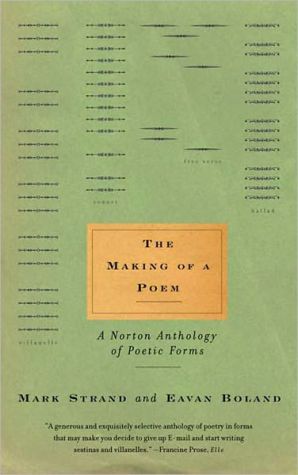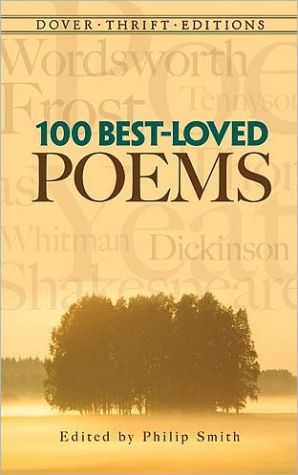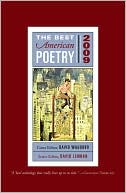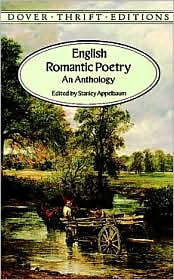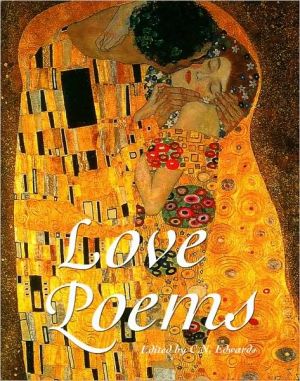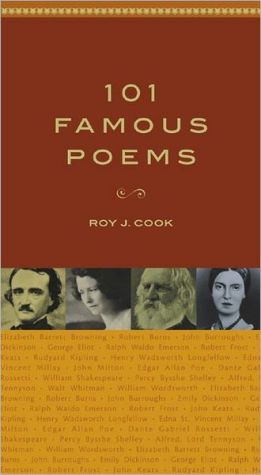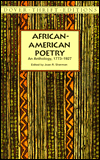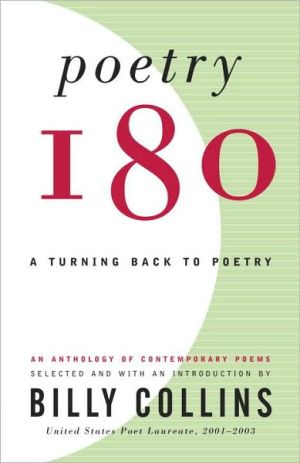Making of a Poem: A Norton Anthology of Poetic Forms
"Concise, learned, revisionary... should enrich the passionate conversation about poetic forms for years to come."— Edward Hirsch, author of How to Read a Poem and Fall in Love with Poetry\ Two beloved and esteemed poets have collaborated on this intimate and useful anthology illuminating the history, practice, and wonder of our most elusive art. Intended for all those who love poetry, including teachers, readers, writers, and students, The Making of a Poem will be especially valued by those...
Search in google:
"Concise, learned, revisionary... should enrich the passionate conversation about poetic forms for years to come."— Edward Hirsch, author of How to Read a Poem and Fall in Love with PoetryMilwaukee Journal SentinelA marvelous new anthology.
Introductory StatementxiiiOn Becoming a PoetxviiPoetic Form: A Personal EncounterxxvAcknowledgmentsxxxiIVerse FormsOverview3The VillanelleThe Villanelle at a Glance5The History of the Form6The Contemporary Context8Villanelle of His Lady's Treasures9The House on the Hill9Missing Dates10The Waking11One Art11Do Not Go Gentle into That Good Night12The World and the Child13Condemned Site13By the Sound14Saturday at the Border15Under the Hill16Villanelle16Reading Scheme17Villanelle for the Middle of the Night18Close-Up of a Villanelle: "One Art"19The SestinaThe Sestina at a Glance21The History of the Form22The Contemporary Context24Ye wastefull woodes, bear witness of my woe25from Old Arcadia26Sestine 4 from Parthenophil and Parthenophe27Sestina: Of the Lady Pietra degli Scrovigni29Sestina30Sestina32Sestina of the Tramp-Royal33Sestina: Altaforte34After the Trial36The Book of Yolek37The Shrinking Lonesome Sestina38Nani39Close-Up of a Sestina: "Sestina: Altaforte"41The PantoumThe Pantoum at a Glance43The History of the Form44The Contemporary Context45In Town45Pantoum of the Great Depression47Parents' Pantoum48Pantoum49Grandmother's Song50The Method51Close-Up of a Pantoum: "Pantoum of the Great Depression"53The SonnetThe Sonnet at a Glance55The History of the Form56The Contemporary Context58Shall I compare thee to a summer's day?59Farewell to Love59from Pamphilia to Amphilanthus60Sonnet XXIII: Methought I saw my late espoused saint60Holy Sonnet: At the round earth's imagined corners61Composed upon Westminster Bridge, September 3, 180261Ozymandias62Bright Star62from Monna Innominata63from Sonnets from the Portuguese (XLIII)63Carrion Comfort64What lips my lips have kissed, and where, and why64From the Dark Tower65Epic65from "Tulips and Chimneys"66To My Mother66After the Bomb Tests67A Game of Chess67The Haw Lantern68Heat68The Roman Baths at Nimes69Half a Double Sonnet69Sonnet70Close-Up of a Sonnet: "What lips my lips have kissed, and where, and why"71The BalladThe Ballad at a Glance73The History of the Form74The Contemporary Context77The Cherry-tree Carol78Sir Patrick Spens79The Wife of Usher's Well81My Boy Willie82The Changeling83from The Ballad of Reading Gaol86Peter and John88Bagpipe Music90Death in Leamington91The Tale of Custard the Dragon92We Real Cool94Riverbank Blues94Ballad of John Cable and Three Gentlemen95Close-Up of a Ballad: "We Real Cool"99Blank VerseBlank Verse at a Glance101The History of the Form102The Contemporary Context104from his translation of The Aeneid105from Tamburlaine the Great105from Julius Caesar106from Paradise Lost107from Beachy Head108from The Prelude109Ulysses110Rain112Directive113Lying114Stanzas in Bloomsbury117Close-Up of Blank Verse: "Directive"119The Heroic CoupletThe Heroic Couplet at a Glance121The History of the Form122from The Description of Cooke-ham123The Author to Her Book123A Letter to Daphnis, April 2, 1685124from Absalom and Achitophel125from The Vanity of Human Wishes126To S. M., a Young African Painter, on Seeing His Works127from The Deserted Village128from An Essay on Criticism129My Last Duchess130Strange Meeting132The J Car133Close-Up of the Heroic Couplet: "My Last Duchess"135The StanzaThe Stanza at a Glance136The History of the Form137The Contemporary Context139from Troilus and Criseyde140from The Faerie Queene141They Flee from Me142Easter Wings143The Tyger143So We'll Go No More A-Roving144I died for Beauty--but was scarce145The Convergence of the Twain145The Song of the Mad Prince146A Quoi Bon Dire147Song of the Son147The Tropics in New York148Night Song at Amalfi149Not Waving but Drowning149On Teaching the Young149Those Winter Sundays150Yes150Warming Her Pearls151Epith152Close-Up of a Stanza: "I died for Beauty--but was scarce"154IIMeterMeter at a Glance159A Brief Checklist of Further Reading on Meter161IIIShaping FormsOverview165The ElegyOverview167Lament for the Makaris168If Ever Hapless Woman Had a Cause171On My First Son172Epitaph. On her Son H.P. at St. Syth's Church where her body also lies Interred172Lycidas173Here Follows Some Verses upon the Burning of Our House July 10th, 1666. Copied out of a Loose Paper178Elegy Written in a Country Churchyard180R. Alcona to J. Brenzaida184O Captain! My Captain!185Dover Beach185To His Love187Bells for John Whiteside's Daughter187Tears in Sleep188In Memory of W. B. Yeats188from The Quaker Graveyard in Nantucket191Dream Song 324194To the Dead194In Memoriam Paul Celan196The Legend197The Elegy for New York198Tiara199Supernatural Love200Mirror in February202Iris203Child Burial204Song205The PastoralOverview207The Passionate Shepherd to His Love209from Love's Labor's Lost210The Garden210To My Sister213Ode on a Grecian Urn214Loveliest of Trees215The Wife of Llew216Urban Pastoral216Remembered Morning217The Thought-Fox217The Explosion218Lying in a Hammock at William Duffy's Farm in Pine Island, Minnesota219Midsummer, Tobago220The Bear220Fog223Let Evening Come224Smoke224Meditation at Lagunitas226From the Porch227A Walrus Tusk from Alaska227Looking West from Laguna Beach at Night228The Broad Bean Sermon229Of the Finished World230Tornados231Loss232Waiting for the Storm233An Engraving of Blake233Pygmalion's Image233Mock Orange234The Black Walnut Tree235Gateposts236Heart of the Matter236Shoeing the Currach238The OdeOverview240Ode to the West Wind241To Autumn243Ode244The Fire of Driftwood245from The Bridge247The Paper Nautilus248Australia 1970249Miracle Glass Co.250The Blue Swallows250America252Ode to Meaning252Perhaps the World Ends Here254IVOpen FormsOverview259The Circus Animals' Desertion260The Love Song of J. Alfred Prufrock262I, Too266The Idea of Order at Key West266Spring and All268America269Ave Maria272Uncertain Oneiromancy273Daddy274Diving into the Wreck276Move279The Language of the Brag280The Colonel281The German Army, Russia, 1943282Starlight Scope Myopia282Reading Plato284Close-Up of Open Forms: "Diving into the Wreck"287A Brief Glossary289Biographies and Further Reading293Suggested Reading335Credits337General Index349Index of Authors, Titles, and First Lines357
\ From Barnes & NoblePoetry's Ingredients: Mark Strand and Eavan Boland Explore Form \ Explaining beauty is hard work. But distinguished poets Mark Strand and Eavan Boland have produced a clear, super-helpful book that unravels part of the mystery of great poems through an engaging exploration of poetic structure. Strand and Boland begin by promising to "look squarely at some of the headaches" of poetic form: the building blocks of poetry. The Making of a Poem gradually cures many of those headaches.\ Strand, who's won the Pulitzer Prize and a MacArthur Fellowship and has served as U.S. Poet Laureate, and Boland, an abundantly talented Irish poet who has also written a beautiful book of essays on writing and womanhood, are both accustomed to teaching. Strand, now at the University of Chicago, and Boland, a Stanford professor, draw upon decades in the classroom to anticipate most questions.\ Ever wonder what a pantoum is? A villanelle? A sestina? With humor, patience, and personal anecdotes, Strand and Boland offer answers. But the way they answer is what makes this book stand out. The forms are divided into three overarching categories: metrical forms, shaping forms, and open forms. "Metrical forms" include the sonnet, pantoum, and heroic couplet. "Shaping forms" explains broader categories, like the elegy, ode, and pastoral poem. And "open forms" offers new takes on the traditional blueprints, exploring poems like Allen Ginsberg's "America."\ Each established form is then approached in three ways, followed by several pages of outstanding poems in that form. First, the editors offer a "page at a glance" guide, with five or six characteristics of that specific form presented in a brief outline. For example, the pantoum is defined like this:\ 1) Each pantoum stanza must be four lines long.\ 2) The length is unspecified but the pantoum must begin and end with the same line.\ 3) The second and fourth lines of the first quatrain become the first and third line of the next, and so on with succeeding quatrains.\ 4) The rhyming of each quatrain is abab.\ 5) The final quatrain changes this pattern.\ 6) In the final quatrain the unrepeated first and third lines are used in reverse as second and fourth lines.\ With this outline, it's easy to identify the looping pantoum. In the second piece of the pantoum section, Strand and Boland include a "History of the Form" section, again condensed to one page. Here, we learn that the pantoum is "Malayan in origin and came into English, as so many other strict forms have, through France." Indeed, both Victor Hugo and Charles Baudelaire tried their hands at the pantoum. As always, Strand and Boland offer some comparison to the other forms, which helps explain why a poet might choose to write a pantoum over, say, a sonnet or a sestina:\ "Of all verse forms the pantoum is the slowest. The reader takes four steps forward, then two steps back. It is the perfect form for the evocation of a past time."\ Next, the editors include "The Contemporary Context," which introduces several of the pantoums of this century. Finally, in what may be the book's best feature, they provide a close-up of a pantoum, an approach they repeat for each form discussed. In this case, it's the "Pantoum of the Great Depression" by Donald Justice. The editors offer some biographical information on Justice, and then they map out how that specific poem gets its power.\ This "poet's explanation" of the workings of a poem is invaluable, especially when it comes from leading poets such as Stand and Boland. What's more, these remarks are transferable. Reading how Strand and Boland view a dozen poems transforms the way one reads. With any future poem, you can look for what Strand and Boland have found in the greats.\ The editors offer their readers a great start, with a list for further reading and a helpful glossary. If anything can get a person excited about poetry, this selection of poems can -- though the editors, as working poets, readily admit their choices are idiosyncratic.\ Gems here include the best work of lesser-known poets, including several "poets' poets." For example, Edward Thomas, a prominent reviewer in his day and a close friend of Robert Frost's, is represented by "Rain," an absolutely brilliant blank-verse poem which begins:\ Rain, midnight rain, nothing but wild rain\ On this bleak hut, and solitude, and me\ Remembering again that I shall die\ And neither hear the rain nor give it thanks\ For washing me cleaner than I have been\ Since I was born into this solitude.\ \ Thomas's poem -- and other treasures here -- introduces readers to what and how poets read to learn to make poems. Of course, many of the usual suspects are found here, but the surprises are exciting, and even the old favorites seem new when the editors explain why and how a particular poem seems beautiful. This is particularly evident in their discussion of Edna St. Vincent Millay's rushing, initially breathless sonnet "What Lips My Lips Have Kissed, and Where, and How, " which reads:\ What lips my lips have kissed, and where, and why,\ I have forgotten, and what arms have lain\ Under my head till morning, but the rain\ Is full of ghosts tonight, that tap and sigh\ Upon the glass and listen for reply,\ And in my heart there stirs a quiet pain\ For unremembered lads that not again\ Will turn to me at midnight with a cry.\ Thus in the winter stands the lonely tree\ Nor knows what birds have vanquished one by one,\ Yet knows its boughs more silent than before:\ I cannot say what loves have come and gone,\ I only know that summer sang in me\ A little while, that in me sings no more.\ \ In the "close-up" section, Strand and Boland offer an biographical paragraph that mentions that in 1923, Millay became the first woman to win a Pulitzer Prize in Poetry. They then discuss Millay's "distinctive and unusual" approach to the sonnet form: "Instead of taking the more leisurely pace of the public sonnet that had been the 19th-century model, she drove her sonnets forward with a powerful lyric music and personal emphasis."\ The editors point out Millay's heavy reliance on assonance and alliteration, and then note how she takes advantage of the different tempos the sonnet offers:\ "Here she uses her distinctive music and high diction to produce an unusually quick-paced poem in the first octave and then a slower, more reflective septet where the abandoned lover becomes a winter tree. This ability of the sonnet, to accommodate both lyric and reflective time, made it a perfect vehicle for highly intuitive twentieth-century poets like Millay."\ That simple explanation of the sonnet as a form able to "accommodate both lyric and reflective time" helps clarify most sonnets. But Strand and Boland are careful not to explain everything. The deepest beauty, as they explain in their introductory essays on their attraction to form, is built on mystery. And it is that attempt to understand the greatest mysteries that defines the greatest poems.\ Similarly, mystery often drives poets to write, as Strand explains in his essay on Archibald MacLeish's "You, Andrew Marvell," which Strand describes as the first poem he wished he had written himself in his early years as a poet:\ "Although I no longer wish I had written 'You, Andrew Marvell,' I wish, however, that I could write something like it, something with its sweep, its sensuousness, its sad crepuscular beauty, something capable of carving out such a large psychic space for itself&. There is something about it that moves me in ways I don't quite understand, as it were communicating more than what it actually says. This is often the case with good poems -- they have a lyric identity that goes beyond whatever their subject happens to be."\ With this book, Strand and Boland help quantify the explicable parts of a "lyric identity." Understanding form, the editors believe, is one way to begin understanding a poem's beauty. This lucid, useful book is a wonderful guide to that mysterious music.\ —Aviya Kushner\ \ \ \ \ \ Edward HirschConcise, learned, revisionary... should enrich the passionate conversation about poetic forms for years to come.\ \ \ Milwaukee Journal SentinelA marvelous new anthology.\ \ \ \ \ KLIATTThis is a wonderfully useful book for teaching students either to understand poetry better or to write it with more sophistication themselves. The book is organized into sections that cover verse form, meter and shape. Each topic gets a quick list of defining elements, brief histories of the form and its contemporary context, and an anthology of varied examples that can run from 5 to 20 poems. A short biography of each poet appears at the end, along with some suggestions for further reading. This is a rich, large anthology on its own, but it aims to counter a big gap in today's students' understanding of literature. KLIATT Codes: SA—Recommended for senior high school students, advanced students, and adults. 2000, Norton, 366p. illus. bibliog. index., $15.95. Ages 16 to adult. Reviewer: Daniel J. Levinson; History & English Teacher, Thayer Acad., Braintree , November 2001 (Vol. 35, No. 6)\ \ \ \ \ Library JournalIf example is the best teacher, than students new to traditional poetic forms can learn much from this collection of villanelles, sestinas, sonnets, elegies, pastorals, ballads, pantoums, odes, and other familiar structures that have shaped English poetry since Beowulf. Each chapter focuses on a single form, but explanatory material is kept to a minimum: a concise list of formal characteristics, a summary history, a short discussion of the form's contemporary context, and a brief "close up" on an individual poem. Most useful are the selections themselves, which illustrate how particular forms have been employed over time, from canonical classics by Chaucer, Shelley, and Elizabeth Bishop through newer pieces by Hayden Carruth, Michael Palmer, and Thylias Moss. The concluding section on open forms seems somewhat uncertain and conservative, barely straying from much of what precedes it, but that's to be expected given the tastes of the editors, each of whom provides a lively and personal introductory essay that young poets should find quite instructive.--Fred Muratori, Cornell Univ. Lib. Ithaca, NY Copyright 2000 Cahners Business Information.\\\ \ \ \ \ BooknewsThis anthology traces the history of poetic forms by example and explanation. Each chapter begins with a brief summary of the structure and origin of a particular form, followed by multiple examples. The authors, who are working poets, present selections in the villanelle, sestina, sonnet, ode, and pastoral forms, among others. The final section examines the open forms of modern poetry. Annotation c. Book News, Inc., Portland, OR (booknews.com)\ \ \ \ \ Kirkus ReviewsAsking two working poets to collectively construct an anthology about poetic form can be a risky proposition. Decisions about which forms to present, which poems most effectively illustrate those forms, and in what context to offer them would be a struggle for even one poet to come to terms with. In this anthology, Pulitzer Prize winner Mark Strand (The Weather of Words, etc.) and Stanford creative writing director Eavan Boland (The Lost Land, etc.) combine their poetic savvy to respond to these issues, resulting in a practical introduction to understanding poetic form. Strand and Boland divide the collection up into sections on metrical, shaping, and open forms. Each section offers outlines of the mechanics associated with each type of poem, a brief history of the form, and a thoughtful collection of poems representative of the form's evolution through history. Each chapter concludes with a brief "close-up" reading of one of the provided poems, which helps situate it in a historical dialog with its poetic ancestors and descendants. Thus Gwendolyn Brooks' Harlem Renaissance ballad "Sadie and Maud" is provocatively situated next to an excerpt from Oscar Wilde's "The Ballad of Reading Gaol." In addition to the ballad, Strand and Boland use this format to introduce and provoke thought about the villanelle, the sestina, the pantoum, the sonnet, blank verse, the heroic couplet, the stanza, the elegy, the pastoral, the ode, and modern open forms. A practical handbook on poetic form for teachers, students, and poets who are interested both in the structural mechanics and literary heritage of poetic forms.\ \
